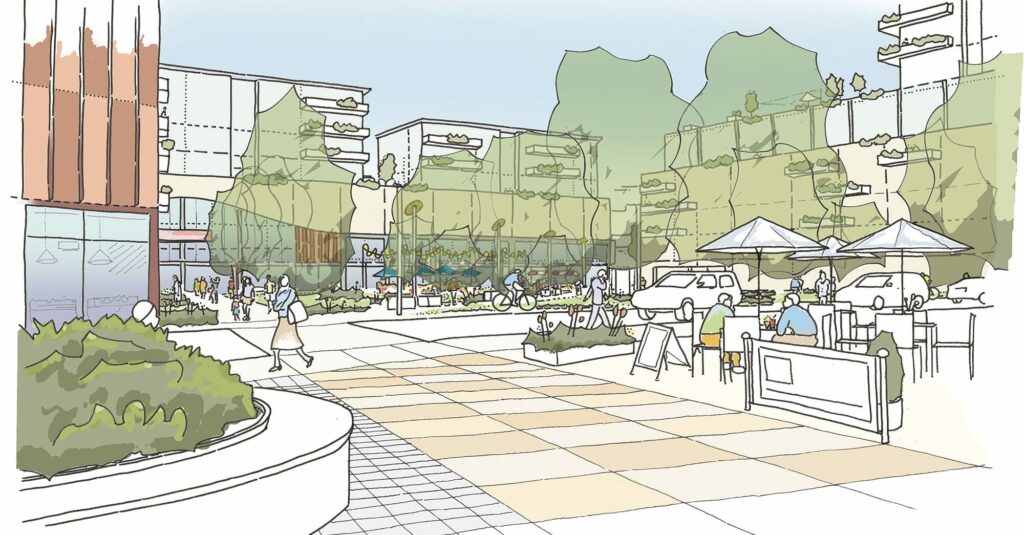While the economy may have technically limped out of recession in June, various reports indicate economic conditions remain challenging for most sectors. Many are making comparisons to the late 1980’s (think share market crash) or the austerity of the early 1990’s. As we’ve seen for some time now, a stalled economy with more business and household caution, is requiring many organisations to make cost savings in response.
Heading into this year, recession has been widely talked about amid ongoing global economic and geopolitical uncertainty, high interest rates (to combat inflation) and weak growth in 2023. As is often the case, the real data often lags sentiment, with the decline of economic growth signalled for some time post the COVID bounce back.
Property provides opportunities
This changing economic environment requires many businesses to take a hard look at their costs – and in many cases, an immediate need to cut costs.
We know that property, whether leased or owned, is the second largest operating cost after people for most organisations – both on an annual and contingent basis. This means it’s a logical place to look for cost efficiencies.
However, reducing property-related costs or freeing up capital from asset sales can be challenging given property is inert by nature; a long-term financial commitment where changes take planning and time to be executed. By comparison, reducing staffing levels can often be done more immediately though this may not always be in the best long-term interests of an organisation. But a reducing workforce and the need for less real estate often eventually correlate.
While identifying immediate property savings can be challenging, there are a number of levers organisations can pull to rationalise their property portfolios or lease costs and find cost efficiencies in the short and longer term.
This requires a multi-dimensional approach looking at property from all angles – including the physical asset, its financial profile and performance, how well it is utilised, how well it is managed and its strategic purpose and alignment with the business. Increasingly, it also requires considering how digital and other technology can complement or substitute the need for further investment in property.
Start with strategy
In a time of recession, it is easy to think about more immediate tactics and put strategy on pause. However, this is the time you need strategy more than ever to help unlock the opportunities for change and opportunities for savings.
For organisations with a multi-site portfolio (to run their business), strategy may involve a critical look at this overall network. Are we in the right locations, do we have too many sites (offices, stores, warehouses…), and how can we right-size our network to better match our future business planning?
This type of strategic planning has a number of follow-on benefits. It requires businesses to fully understand their portfolio, key data and dates, current and forecast costs and critical decisions that are pending that may either worsen the current position or create opportunities to reduce cost. For example, should we renew this lease that’s due to expire or is there an alternative solution? Doing this work puts businesses in the best place to make informed decisions.
These pre-planning insights could lead to asset disposal or sale and leaseback initiatives (to free up capital), or lease exit, renegotiation or sub-leasing of leased sites as part of a complete portfolio rationalisation.
A region-by-region and site-by-site review may reveal other opportunities for change to ensure the property is best matched to forecast future strategic and operational needs. These findings often lead to operating and capital cost savings.
Become data-centric
It still surprises me that many large organisations still manage their leased and owned facilities, and second biggest cost, using a spreadsheet. And often those that have adopted technology solutions are not using the full capability or maintaining data accuracy.
This often means there is not a full understanding of the scope and scale of the portfolio, missing data, missed critical dates and opportunities, unreconciled costs sitting within landlord pockets and poor reporting and governance.
Our Strategy22 team commence portfolio reviews and rationalisation assignments building a top-down view on the portfolio, putting themselves in the position of senior decision makers and asking what data they would want to/need to see. This often results in undertaking data audits and building property and portfolio dashboards to provide a single page view on the critical data and critical numbers. This task alone often draws out immediate insights and opportunities by studying trends, outlying data and misalignment with business strategy and plans.
Alternatively, the data is migrated into our Portfolio22 SaaS platform, where similar dashboards can be developed and real-time scenario planning undertaken more easily.
Either way, a single source of truth and reliable data is essential to allow any key moves to be considered. Without these insights, organisations are blind to the cost savings opportunities and wider risks.
Challenge utilisation
Often in a growing economy, property becomes a ‘lazy asset’ as organisations expand, lease or acquire more real estate or workspace or refurbish existing sites. Space utilisation and performance metrics get lost in the focus on accommodating increased headcount, nurturing employee experience and growth mantras.
At the same time, businesses are still also adjusting to the post-COVID return to work ‘new normal’. Each organisation has adopted its own hybrid working solution. Many have seen a positive return to the office (across the knowledge economy), but some are also seeing variable occupancy levels and low Monday and Friday head counts.
Getting real-time data on the actual occupancy levels over a period of time, gives leaders more accurate data to make better informed decisions. This data provides a definitive view of real-world usage, demand and utilisation. This could lead to reducing the space occupied (either at the next lease exit or renewal opportunity) or sub-leasing or quitting space as needed, and corresponding savings.
Increasingly, utilisation technology uses infra-red sensor technology allowing analysis to be undertaken 24/7 providing real-time data, at low cost. This includes TwentyTwo’s own technology and online interactive portal (Utilisation22) which has been deployed to several clients. In the case of a tertiary education client, the data gave them confidence to sub-lease part of their central campus as the spaces were not fully used.
Utilisation22 is relevant for any organisation, particularly for organisations with multiple workplaces, campuses or specialist facilities. Individual rooms, meeting rooms, floors or entire buildings can be assessed depending on the specific issues being considered. Sensors can be deployed for a defined period or permanently installed for ongoing measurement.
Assess your maturity
If you are lacking reliable data and insightful reporting, your business probably has other gaps in its ‘property or lease management’ maturity. Even if your organisation has been an early adopter of technology-based platforms, you need a highly-performing management function to execute changes and savings.
Achieving gold standard is not the objective. However, if you are going to use property as a catalyst for change and unlock true savings, you need confidence in the capability of your team, whether that is in-house or provided on an outsourced basis.
We use a High-Performance Framework to assess the maturity of the property function, against eight critical areas that are needed. Running your property function against this framework will not only identify gaps that can be progressively closed, but also opportunities to reduce cost, both within the portfolio and in how the portfolio is managed.
Do you have too many people/too much cost associated with managing your owned or leased property relative to its scale and relative to the resourcing used by similar portfolios? Is your organisation missing opportunities to reduce cost or get better commercial outcomes because it has the wrong people in the wrong roles?
All of these questions need to be considered if you want to drive change and reduce cost, both immediate operating costs and long-term commitments.
In some cases, reducing your in-house resourcing and supplementing with external advice may be more cost effective. Alternatively, putting in place the right management arrangements and resourcing may provide the improvement in maturity sought.
Invest in technology
The optimal platform needed to support business success is often referred to as a three-legged stool – property, people and technology. Most organisations need each of these disciplines as part of its enabling infrastructure.
Increasingly, technology is becoming a substitute for conventional physical investment. That is particularly the case in how organisations adjust to a new hybrid workplace, with the changing nature of work accelerated by COVID. I heard one client recently refer to technology as creating the ‘fourth campus’ in reference to strengthening their digital environment in addition to their three existing physical locations.
We are all now using hybrid meetings each day, with some people in the room and some joining remotely, from both within the organisation and externally. The uptake of technology to make all this happen has been phenomenal.
But it takes more than the kit to make these events seamless and to give leaders confidence they can host a virtual meeting and not have to fly people in for critical meetings. Designing the rooms and spaces as technology-led environments is the key. “You can’t beat physics” as Matthew Peko-Fox, our Chief Technology Strategist says. Lighting, acoustics, furniture, wall and floor surfaces along with the tailored design of the system are critical.
Through our Technology22 practice, providing independent technology advice, we are seeing clients being more confident hosting meetings because they trust the technology will work! This is leading to reduced travel costs for some clients, like a major consulting firm we support across the country.
In a tighter economy, travel can form a substantial chunk of business expenditure. Consider, for instance, the expenses associated with business trips with flight tickets, hotel bills, meals, local travel. It is possible to eliminate most of these costs through investing in fine-tuning virtual meeting tools to ensure you are set up for an optimal experience. It’s a smart investment and a strategic move towards efficient business operations. Alongside cost efficiencies, virtual meetings also save time and generally lead to enhanced productivity.
Summary
In over 30 years of providing independent strategic and commercial advice, I’ve seen challenging economic times come and go. COVID was the most recent challenge for many. This period will be no different. Often a rebalancing of the economy forces organisations to adjust and right size to take advantage of the next phase of growth.
As businesses look to adjust from reducing revenues, don’t think property is simply a fixed cost that is not ripe for change. There are many levers that can be pulled but this requires a well-thought-through deliberate strategy and acute expertise and experience to chase the opportunities that are worth exploring.



